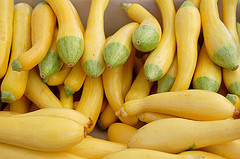Summer Squash
| Infobox on Summer Squash | |
|---|---|
| Example of Summer Squash |  |
| Freshness facts | |
| Optimum carrying temperature | 8°C to 10°C |
| Highest freezing point | -0,4°C |
| Acceptable product temp. at loading into containers | Max. 2°C above carrying temperature |
| Optimum humidity | 90% to 95% |
| Ventilation setting for containers | 10 m³/hr |
| Storage life | 1 week |
| Climacteric / non-climacteric | Non-climacteric |
| Ethylene production | Low |
| Ethylene sensitivity | Medium |
| Modified / controlled atmosphere | 2% to 4% O2; 10% CO2 |
| Potential benefits | See text |
| Availability | |
| On demand | |
Summer Squash
Contents
Harvesting and Handling
There are six horticultural groups of Summer squash: cocozelle, crookneck, scallop, straightneck, vegetable marrow and zucchini.
Tenderness and firmness are the major quality characteristics. The surface of Summer squash should be shiny; dullness is a sign of senescence. Fruit should be firm and free of physical injury. Dark green types should be entirely green; yellowish areas are a sign of senescence. Water loss results in a dull surface and loss of firmness.
Squash are packed in a variety of containers including bushel baskets, wire-bound wooden crates and fibreboard boxes. A plastic liner should be used in all wooden containers to prevent abrasion and retard water loss. All types of Summer squash are extremely tender and are injured by the slightest scratch, bruise, or scuff. The yellow and scalloped squash show scuffing clearly because the ensuing darkening is obvious on a light background.
Cooling and Storage
Prompt pre-cooling after harvest reduces the rate of water loss and is essential for maximum postharvest life. Summer squash are highly perishable and not suited for storage longer than 2 weeks. For maximum shelf-life, Summer squash should be held at 5°C to 10°C with 95% RH.
Summer squash are chilling sensitive and should not be exposed to temperatures <5°C. However, variation in chilling tolerance among Summer squash types is great. Chilled Summer squash show surface pitting and decay rapidly at non-chilling temperatures, although damage may be absent during refrigeration. Chilled fruit have increased rates of water loss upon transfer to non-chilling temperature.
Controlled atmosphere considerations
Storage in low O2 atmospheres appears to be of little or no value for zucchini squash.
Storage disorders
Alternaria rot, Anthracnose, Bacterial rots, Black rot, Chilling injury, Cottony leak, Fusarium, Watery soft rot.











